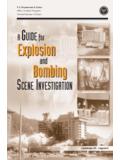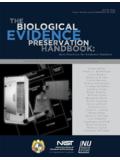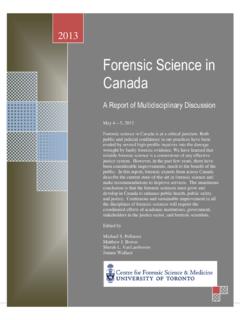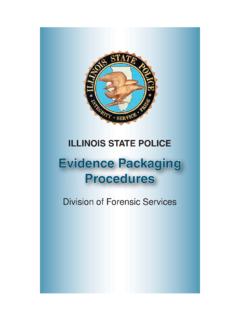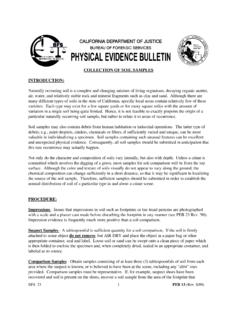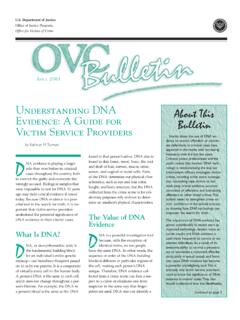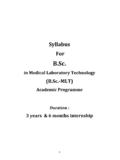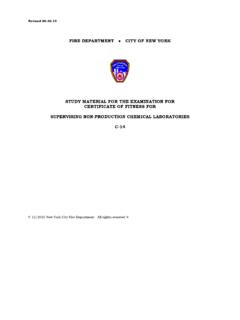Transcription of ARKANSAS STATE CRIME LABORATORY
1 Serology Quality Manual Document ID: SER-DOC-01 Approved By: Executive Director/Scientific Operations Director Revision Date: 04/30/10 Page 1 of 37 ARKANSAS STATE CRIME LABORATORY Serology Quality Manual 2010 Serology Quality Manual Document ID: SER-DOC-01 Approved By: Executive Director/Scientific Operations Director Revision Date: 04/30/10 Page 2 of 37 TABLE OF CONTENTS 1 INTRODUCTION (GOALS AND OBJECTIVES) 5 Organization and Management Structure 5 Organization 5 Management 5 2 PERSONNEL QUALIFICATIONS AND JOB DESCRIPTIONS 6 Job Descriptions 6 Chief Criminalist/Serologist 6 Forensic Serologists 7 Educational Requirements 9 CRIME LABORATORY Chief Criminalist 9 Forensic Serologist 9 Special Training Requirements 9 Training Prior to Casework 9 Continuing Education 10 Current Literature 10 Training Sessions 10 Documentation of Training 10 Meetings 10 3 FACILITIES/SECURITY 11 ARKANSAS STATE CRIME LABORATORY 11 Forensic Serology Unit 11 4 EVIDENCE CONTROL 12 Secure Storage 12 Temporary storage within the section
2 12 Long-term storage within the section 12 Evidence Handling 12 Documentation of Evidence and Packaging 12 Release of Evidence 13 Disposition 13 Destruction 13 Evidence Assessment 13 Evidence Assessment by Supervisor 13 Evidence Assessment by Analyst 14 5 VALIDATION 15 Serology Quality Manual Document ID: SER-DOC-01 Approved By: Executive Director/Scientific Operations Director Revision Date.
3 04/30/10 Page 3 of 37 6 ANALYTICAL PROCEDURES (SOP) 16 Collection of Hairs and Fibers 16 Evidence Assessment by Analyst 16 Testing Techniques 16 Collection from Sexual Assault Kits 16 Collection from Clothing or Other Items 17 Notes/Documentation 17 Assessment of Results 17 Review of Evidence Collected 17 Report Writing Suggestions 18 Analytical Procedures - Seminal Fluid Screening 18 BCIP 18 Principle 18 Materials 18
4 Reagent Preparation 18 Procedure 19 Interpretation of Results 19 Trouble Shooting 19 Extraction of Suspected Semen Stains For Analysis of Soluble and Particulate Seminal Components 19 Principle 20 Materials 20 Materials for HEPES Preparation 20 Reagent Preparation (HEPES) 20 Procedure 20 Preparation Of Slide From Pellet 21 Christmas Tree Stain For Spermatozoa 21 Reagent Preparation 21 Staining Procedure 21 Results 21 Identification of Semen Using The Seratec PSA Semiquant 22 Principle 22 Materials 22 Procedure 22 Controls 23 Interpretation 23 Identification of Semen Using The ABAcard 23 Principle 23 Materials 23 Procedure 23 Controls 24 Interpretation 24 Identification of Semen Using the Rapid Stain Identification of Human Semen (RSID-Semen)
5 Test 25 Principle 25 Materials 25 Procedure 25 Controls 25 Interpretation 25 Alternate Light Source (ALS) Examination 26 Purpose 26 Method 26 Cautions 26 Serology Quality Manual Document ID: SER-DOC-01 Approved By: Executive Director/Scientific Operations Director Revision Date: 04/30/10 Page 4 of 37 Safety Hazard 27 Preparation and Use of Phenolphthalein Presumptive Test Reagent 27 Principle 27 Materials 27 Reagent Preparation 27 Preparation and Use of Takayama Confirmatory Test Reagent 28 Principle 28 Materials 28 Reagent Preparation 29 Procedure 29 Controls 29 Interpretation 29 7 INSTRUMENT/EQUIPMENT CALIBRATION MAINTENANCE 31 8 PROFICIENCY TESTING PROGRAM 32 9 CASE RECORDS 33 Documentation 33 Release of Information 33 Technical and Administrative Reviews
6 33 10 TESTIMONY REVIEW 34 11 AUDITS 35 12 COMPLAINTS 36 13 SAFETY 37 Serology Quality Manual Document ID: SER-DOC-01 Approved By: Executive Director/Scientific Operations Director Revision Date: 04/30/10 Page 5 of 37 FORENSIC SEROLOGY 1 INTRODUCTION (GOALS AND OBJECTIVES) The Forensic Serology unit is dedicated to providing forensic analysis of physical evidence to the criminal justice system. To this end, we analyze evidence, such as swabs, clothing, weapons and bedding, that may contain body fluids. Other physical evidence such as hairs.
7 Fibers and debris may be collected for future analyses. These analyses are performed in a chain-of-custody environment using proper and appropriate procedures in order to ensure the most accurate and relevant analytical results. Organization and Management Structure Organization The Serology Unit is part of the Physical Evidence Section. The Physical Evidence Section has a supervisor and is under the supervision of the Scientific Operations Director. Management This manual has been approved by the Section Supervisor, Scientific Operations Director, and Executive Director and as such is accepted as the routine operating policy of the Forensic Serology Unit within the ARKANSAS STATE CRIME LABORATORY . To discuss possible revisions, meetings between the Section Supervisor and the analysts will be held as needed. Any changes to this manual must be approved through formal chain of command processes, with affected manual pages and files updated.
8 Previous versions of revised documents are maintained in a separate Historical Archive Manual. All analysts must be notified of the changes and must be given necessary training. Serology Quality Manual Document ID: SER-DOC-01 Approved By: Executive Director/Scientific Operations Director Revision Date: 04/30/10 Page 6 of 37 2 PERSONNEL QUALIFICATIONS AND JOB DESCRIPTIONS Job Descriptions Chief Criminalist/Serologist EXAMPLES OF WORK A. Supervises a professional staff of Trace Evidence Analysts and Serologists by interviewing and recommending for hire; training or providing training opportunities; assigning and reviewing work and evaluating the performance of incumbents. B. Coordinates section activities by reviewing, prioritizing and assigning new cases; providing assistance to staff in regard to appropriate testing methods and findings; and reviewing selected final reports.
9 C. Reviews investigator's summary sheet to become familiar with the details of the CRIME and examines items such as gunshot residue, fire debris, hair, fiber, body fluids, paint, glass and soils submitted as potential evidence to determine appropriate testing methods. D. Designs and conducts a series of analytical tests (including chemistry, chromatography, mass spectography; and transmitted light, stereo and electron microscopy and body fluid identification tests) to try to determine physical and chemical properties of evidence items and identity of evidence items. E. Prepares reports of findings and conclusions for submission to legal authorities and courts of law. F. Testifies in court as an expert witness on the analysis of evidence and conclusions reached. G. Writes articles, presents training and provides consultation to law enforcement officers, prosecutors, defense attorneys and other public officials on CRIME scene investigation; methods of collecting, transporting and preserving evidence to ensure its integrity and maintenance of the chain of custody.
10 H. Researches scientific literature and exchanges information with peers in other states in order to stay abreast of the latest scientific advances in the analysis of criminal evidence and/or determine the best method of testing a particular piece of evidence. I. Performs administrative duties by preparing activity reports, inventory reports; maintaining employee history information and equipment maintenance logs; requisitioning supplies and equipment; and researching and recommending policies/procedures. Serology Quality Manual Document ID: SER-DOC-01 Approved By: Executive Director/Scientific Operations Director Revision Date: 04/30/10 Page 7 of 37 J. Conducts on-site CRIME scene investigations at the request of law enforcement agencies after gaining approval from the Executive Director or the Scientific Operations Director.
